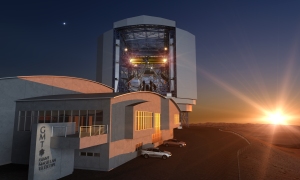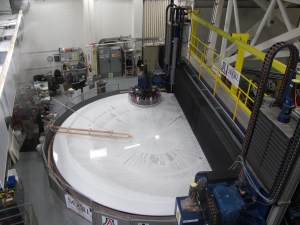The Giant Magellan Telescope

Credit: GMTO Corporation
Space news (March 31, 2016) – high up on an Andes Mountain peak in Las Campanas, Chile –
High up on the dry, barren Cerro Las Campanas in the Atacama Desert in Chile construction of the Giant Magellan Telescope (GMT) began on November 11, 2015. The latest of many state-of-the-art telescopes housed in the Las Campanas Observatory, the GMT implements primary mirrors that are a marvel of modern engineering and glassmaking. Part of a new breed of super-giant-sized ground-based telescopes, it’s designed to open windows peering into unknown regions of the cosmos.

Credit: GMTO Corporation
Six 27-foot (8.4 meters) mirror segments surround a central mirror, forming an optical surface 80-feet in diameter with a total light-collecting area of 3961 sq ft (386 square meters). Light from the edge of the cosmos will reflect off of the primary mirrors, strike seven smaller, flexible secondary mirrors, and then hit the center mirror before heading to advanced CCD imaging devices. The concentrated light is then measured to determine distance and composition of the material at the edge of the universe.

Credit: GMTO Corporation
Utilizing a flexible secondary mirror with a surface capable of adjusting to counteract atmospheric turbulence, the GMT will have a resolving power ten times greater than the Hubble Space Telescope. Gathering more light than any telescope ever designed or engineered, controlled by advanced, state-of-the-art computers, it will transform twinkling lights into clear, steady points of light. Known as “adaptive optics” the actuators under the surface of the secondary mirrors constantly adjust, allowing the GMT to see through the Earth’s atmosphere.
The light gathering ability and resolution of the GMT can image light reflected off of exoplanets orbiting stars light-years away, despite the glare of the host star. One day, light reflected off a rocky planet, much like Earth, will fall upon the mirror assembly of the Giant Magellan Telescope (GMT). Analysis of the light will show a blue planet, with oxygen in the atmosphere and soil, much like Earth. A planet capable of acting as a cradle for a new human Genesis, if we can travel to it?
Perched on a dry Andes mountain at 8,500 ft (2,550 meters), the air above the telescope’s clear and clean, and the night sky dark. From here, the GMT will give us insight into the makeup of stellar matter that formed the first galaxies to appear after the Big Bang. The mystery of dark matter and dark energy and the ultimate fate of our universe. The destinations and secrets of the cosmos it reveals will alter our view of reality and understanding of the bigger universe. The Giant Magellan Telescope’s our next great spaceship-to-the-stars.
Boarding passes available sometime in 2021!
Watch this YouTube video on the GMT.
Read about the weird light signal being emitted by two orbiting black holes destined to merge.
Read about clues found by astronomers concerning the formation and evolution of the Milky Way.
Learn more about astronomers confirmation of data proving an ocean of liquid water exists beneath the ice.
Learn more about the Giant Magellan Telescope here.
Discover the secrets of the Las Campanas Observatory.
Take the journey of NASA here.

